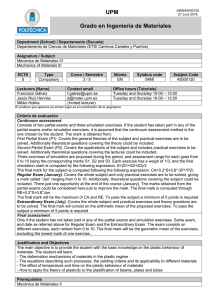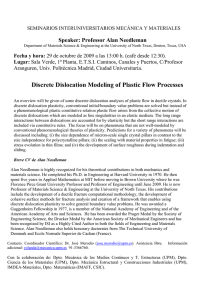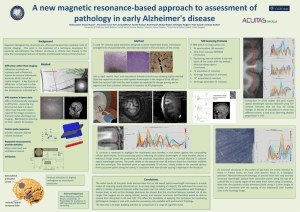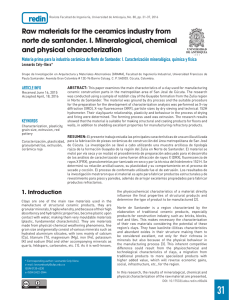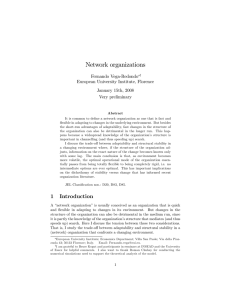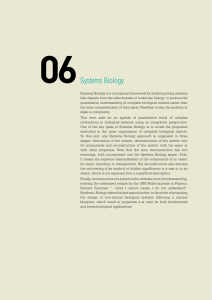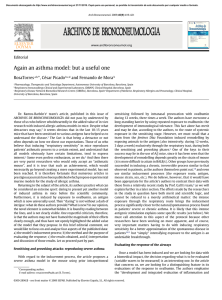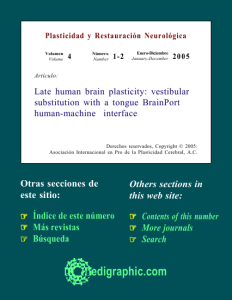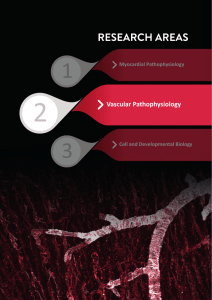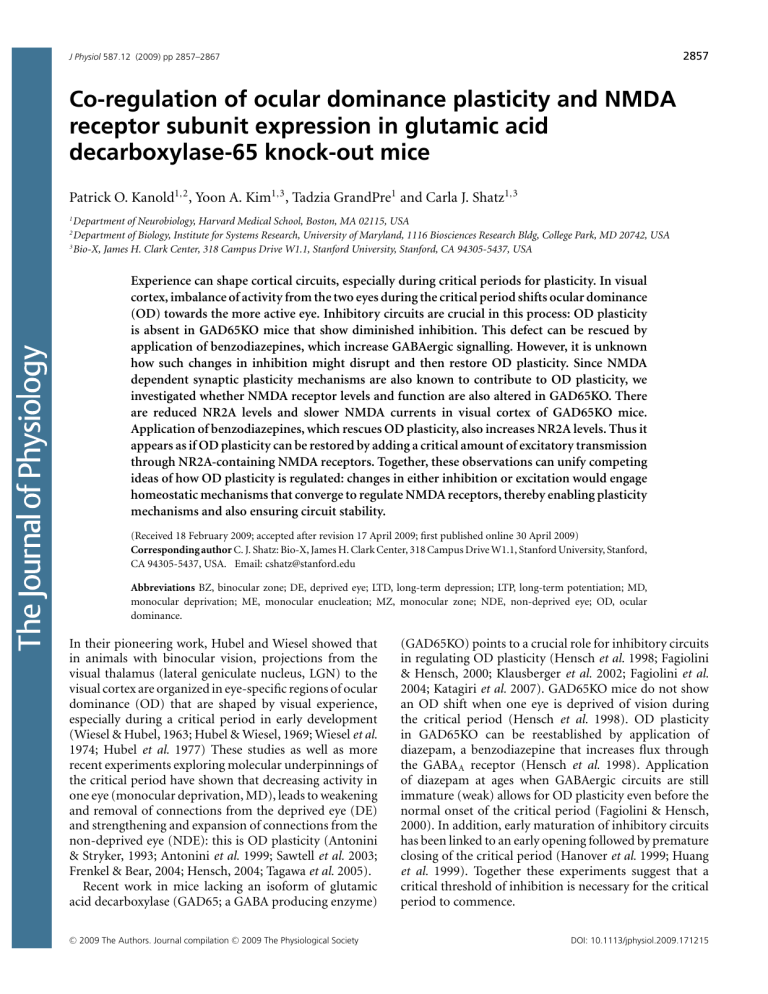
2857 J Physiol 587.12 (2009) pp 2857–2867 Co-regulation of ocular dominance plasticity and NMDA receptor subunit expression in glutamic acid decarboxylase-65 knock-out mice Patrick O. Kanold1,2 , Yoon A. Kim1,3 , Tadzia GrandPre1 and Carla J. Shatz1,3 1 Department of Neurobiology, Harvard Medical School, Boston, MA 02115, USA Department of Biology, Institute for Systems Research, University of Maryland, 1116 Biosciences Research Bldg, College Park, MD 20742, USA 3 Bio-X, James H. Clark Center, 318 Campus Drive W1.1, Stanford University, Stanford, CA 94305-5437, USA 2 Experience can shape cortical circuits, especially during critical periods for plasticity. In visual cortex, imbalance of activity from the two eyes during the critical period shifts ocular dominance (OD) towards the more active eye. Inhibitory circuits are crucial in this process: OD plasticity is absent in GAD65KO mice that show diminished inhibition. This defect can be rescued by application of benzodiazepines, which increase GABAergic signalling. However, it is unknown how such changes in inhibition might disrupt and then restore OD plasticity. Since NMDA dependent synaptic plasticity mechanisms are also known to contribute to OD plasticity, we investigated whether NMDA receptor levels and function are also altered in GAD65KO. There are reduced NR2A levels and slower NMDA currents in visual cortex of GAD65KO mice. Application of benzodiazepines, which rescues OD plasticity, also increases NR2A levels. Thus it appears as if OD plasticity can be restored by adding a critical amount of excitatory transmission through NR2A-containing NMDA receptors. Together, these observations can unify competing ideas of how OD plasticity is regulated: changes in either inhibition or excitation would engage homeostatic mechanisms that converge to regulate NMDA receptors, thereby enabling plasticity mechanisms and also ensuring circuit stability. (Received 18 February 2009; accepted after revision 17 April 2009; first published online 30 April 2009) Corresponding author C. J. Shatz: Bio-X, James H. Clark Center, 318 Campus Drive W1.1, Stanford University, Stanford, CA 94305-5437, USA. Email: [email protected] Abbreviations BZ, binocular zone; DE, deprived eye; LTD, long-term depression; LTP, long-term potentiation; MD, monocular deprivation; ME, monocular enucleation; MZ, monocular zone; NDE, non-deprived eye; OD, ocular dominance. In their pioneering work, Hubel and Wiesel showed that in animals with binocular vision, projections from the visual thalamus (lateral geniculate nucleus, LGN) to the visual cortex are organized in eye-specific regions of ocular dominance (OD) that are shaped by visual experience, especially during a critical period in early development (Wiesel & Hubel, 1963; Hubel & Wiesel, 1969; Wiesel et al. 1974; Hubel et al. 1977) These studies as well as more recent experiments exploring molecular underpinnings of the critical period have shown that decreasing activity in one eye (monocular deprivation, MD), leads to weakening and removal of connections from the deprived eye (DE) and strengthening and expansion of connections from the non-deprived eye (NDE): this is OD plasticity (Antonini & Stryker, 1993; Antonini et al. 1999; Sawtell et al. 2003; Frenkel & Bear, 2004; Hensch, 2004; Tagawa et al. 2005). Recent work in mice lacking an isoform of glutamic acid decarboxylase (GAD65; a GABA producing enzyme) C 2009 The Authors. Journal compilation C 2009 The Physiological Society (GAD65KO) points to a crucial role for inhibitory circuits in regulating OD plasticity (Hensch et al. 1998; Fagiolini & Hensch, 2000; Klausberger et al. 2002; Fagiolini et al. 2004; Katagiri et al. 2007). GAD65KO mice do not show an OD shift when one eye is deprived of vision during the critical period (Hensch et al. 1998). OD plasticity in GAD65KO can be reestablished by application of diazepam, a benzodiazepine that increases flux through the GABA A receptor (Hensch et al. 1998). Application of diazepam at ages when GABAergic circuits are still immature (weak) allows for OD plasticity even before the normal onset of the critical period (Fagiolini & Hensch, 2000). In addition, early maturation of inhibitory circuits has been linked to an early opening followed by premature closing of the critical period (Hanover et al. 1999; Huang et al. 1999). Together these experiments suggest that a critical threshold of inhibition is necessary for the critical period to commence. DOI: 10.1113/jphysiol.2009.171215 2858 P. O. Kanold and others How then does inhibition influence the synaptic rearrangements underlying OD plasticity? Multiple lines of evidence suggest that the experience-dependent tuning of visual cortical circuits during the critical period depends on NMDA-dependent mechanisms of synaptic plasticity such as long-term potentiation (LTP) and long-term depression (LTD), both of which exist in visual cortex (Kirkwood & Bear, 1994, 1995; Kirkwood et al. 1995; Bear & Rittenhouse, 1999; Malenka & Bear, 2004). The functional properties of NMDA receptors are determined by the expression ratios of the NR2A and NR2B subunits. Both age and experience regulate these levels (Carmignoto & Vicini, 1992; Quinlan et al. 1999a,b; Roberts & Ramoa, 1999), and they also change the induction properties of LTP and LTD, as well as OD plasticity (Philpot et al. 2001; Sawtell et al. 2003). Since both NMDA and GABA receptors are regulated by manipulations that also influence OD plasticity, we hypothesized that manipulations of GABAergic function that are known to affect OD plasticity, such as occurs in the GAD65KO, might also engage NMDA-dependent mechanisms. It is well established that the levels of excitation and inhibition in neuronal networks are co-regulated by homeostatic mechanisms (Turrigiano, 1999), and homeostatic mechanisms are also thought to be engaged following monocular visual deprivation (Mrsic-Flogel et al. 2007). Thus, reducing GABA release, as occurs in the GAD65KO mice, might elicit a homeostatic readjustment of excitatory NMDA transmission and thereby affect plasticity mechanisms. Evidence that inhibitory GABAergic and excitatory NMDA transmission can be co-regulated comes from studies showing that manipulations that alter OD plasticity also alter both NMDA and GABA receptors (Carmignoto & Vicini, 1992; Huang et al. 1999; Quinlan et al. 1999a,b; Roberts & Ramoa, 1999; Morales et al. 2002; Jiang et al. 2005). These experiments suggest that there might be an underlying common requirement for a critical balance between excitation and inhibition in OD plasticity. Here we explore this suggestion by examining NMDA and GABA receptor levels in GAD65KO and the effects of diazepam on both transmitter systems. Our results show that NR2A-containing NMDA receptors are regulated by inhibition, consistent with the idea that the relative expression ratio of NR2A to NR2B correlates with, and may be a crucial determinant of, the ability to induce OD plasticity. Methods GAD65KO mice on C57/Bl6 background (B6.129x1-Gad2/J) were obtained from The Jackson Laboratory (Bar Harbor, ME, USA). Heterozygous (+/−) mice were bred and −/− (KO) and +/+ (WT) littermates were compared. All procedures were approved J Physiol 587.12 by the Harvard Medical School Animal Care and Use Committee. In situ hybridizations Animals were killed with an I.P. overdose of sodium pentobarbital (200 mg kg−1 to effect) and the brains were rapidly removed and frozen in cryoprotective medium (M1, Shandon, Thermo Electron Corporation, Waltham, MA, USA). Horizontal sections were cut (12–15 μm) on a cryostat. In situ hybridizations are performed as described previously (Kanold et al. 2003; Tagawa et al. 2005). Template sequences were generated from full length Arc clone (gift from P. Worley, Johns Hopkins University, MD, USA). 35 S-labelled riboprobes were generated by in vitro transcription. After hybridization, sections were processed, dipped with autoradiographic emulsion (Kodak NTB-2) and exposed for 3–6 weeks. Darkfield images were acquired with a CCD camera (Spot). The borders between layers were chosen according to adjacent cresyl violet stained sections. Sense probes yielded only background levels of signal (Tagawa et al. 2005; Syken et al. 2006). Densitometric scans of Arc induction in specific cortical layers Quantitative analysis of Arc expression was performed in MATLAB (The Mathworks, Inc., Natick, MA, USA) by line scans in layer 4 as described previously (Tagawa et al. 2005; Syken et al. 2006). Five to fifteen sections from each animal were scanned. The analyses were performed blind to genotype and manipulation; slides from different animals and manipulations were interleaved with each other and only reassembled once they were decoded. For each section, a line was generated along the centre of the chosen layer by selecting 20–100 points, and then performing a cubic spline interpolation between these points. At every pixel along this line, a perpendicular line through the layer (30–60 pixels long; 1 pixel = 1.75 μm) was computed and the average signal intensity of pixels along this line was measured. The resulting intensity line scan was low pass filtered (7 pt triangular), generating a curve of Arc signal intensity versus distance along the layer of interest. Arc signal rose from a minimum in both V1 and V2 to a maximum within the binocular zone (BZ). The width of the BZ, encompassing binocular regions in V1 and V2, was measured as the region around the intensity maximum in which signal intensity is greater than 2 standard deviations of the Arc background signal intensity (determined as average intensity of 30 pixels in the region of minimum Arc induction outside the BZ; this method would if anything underestimate BZ width). The area of V1 and V2 in which Arc induction is at a minimum is defined as the monocular zone (MZ). C 2009 The Authors. Journal compilation C 2009 The Physiological Society J Physiol 587.12 NMDA receptors and OD plasticity in GAD65KO mice Real-time quantitative PCR analyses RT-qPCR was performed as described previously (Tagawa et al. 2005; Kanold & Shatz, 2006). Mice were killed and brains removed. V1 and V2 were microdissected from coronal 2 mm-thick brain slices cut on an acrylic matrix (Ted Pella, Inc., Redding, CA, USA) and frozen immediately on dry ice. Total RNA was isolated using Ambion RNAqueous-Micro cDNA Synthesis Kit (cat. no. 1931, Ambion, Inc., Austin, TX, USA). cDNA was synthesized using the iscript cDNA synthesis kit (Bio-Rad cat. no. 170-8891). A reaction mix contained 1X iQ SYBR Green Supermix (Bio-Rad Laboratories, CA, USA), 100 nM each oligonucleotide primers and 10 ng of cDNA in a 25 μl total volume. The relative amount of mRNA was normalized to the level of internal control message, hypoxanthine phosphoribosyltransferase (HPRT). HPRT(nm_013556) Fwd: TGCTCGAGATGTCATGAAGG, Rev: TATGTCCCCCGTTGACTGAT. GABA A α1 (m86566) Fwd: CCCGTTCAGTGGTTGTAGCA, Rev: CTCTGTTGAGCCAGAAGGAGAC KCC2 (nm_ 020333) Fwd: GTGCCCAGGTAGAAGCAGAG Rev: CACAGCCATTTCCATGAGTG NR2A (nm_ 008170) Fwd: CAACGAAGGGATGAATGTGA Rev: ACAAAGGGCACGGAGAAGT NR2B (nm_008170) Fwd: TGCTACAACACCCACGAGAA Rev: CTCCTCCAAGGTAACGATGC Real-time PCR data analysis was performed according to the comparative threshold cycle (C T ) method. Differences in threshold crossing cycle between mRNA of target gene and HPRT (= Dgene) were calculated for each condition. Then the levels of mRNA expression were computed as 2(Dgene) . Individual animal samples were run in triplicate at each reaction on a 96-well plate allowing us to run 32 samples simultaneously. For comparison each run contained either WT and KO or WT and KO+diazepam samples and we always compared our gene of interest (i.e. NR2A) and our internal control (HPRT) in the same run. We found that this experimental scheme allowed us the highest sensitivity. Thus, each run contained 16 distinct measurements. We then performed paired comparisons of our three conditions. Western blots Mouse brains were dissected and homogenized in approximately 10 volumes of ice cold buffer containing 1% NP40, 150 mM NaCl, 50 mM Tris (pH 7.4), 1 mM sodium fluoride, 1 mM sodium fluoride, 1 mM sodium vanadate, and protease inhibitors (Roche inhibitor cocktail). Samples were centrifuged at 13 000 rpm and diluted in SDS sample buffer. Samples were separated by SDS-PAGE, transferred to PVDF or nitrocellulose membranes, probed with the appropriate antibody (NR2A, NR2B, GAD65, GABAAα1 from Upstate Biotechnology, Inc. (Lake Placid, C 2009 The Authors. Journal compilation C 2009 The Physiological Society 2859 NY, USA) and ERK from Cell Signaling Technology, Inc. (Beverly, MA, USA)), and visualized with enhanced chemilumenesence (Pierce Biotechnology, Inc., Rockford, IL, USA) and Kodak XAR-5 film using multiple exposures. Protein levels were measured by scanning the film and quantifying the optical density of a equal sized region encompassing each band and subtracting background level. To normalize for loading differences, receptor protein levels were then normalized to ERK. Paired samples for KO and WT comparison or KO+diazepam and WT comparison were run on the same gel and protein levels in each gel were normalized to the average WT levels for that gel. OD plasticity experiments and diazepam application Animals were deeply anaesthetized with 4% isofluorane (Halocarbon), and monocular enucleation (ME) performed at P25 under aseptic conditions as described previously (Tagawa et al. 2005; Syken et al. 2006). ME at the ages and for the periods of time used here (∼10 days) does not change the spatial pattern of LGN activation but results in robust OD shifts in visual cortex (Tagawa et al. 2005). ME is well suited for Arc induction experiments as it yields a robust intraocular activity imbalance in the induction phase compared to MD where light can penetrate the closed eyelid and increase activity in connected circuits. Thus ME enhances the signal to noise ratio compared to MD. For rescue experiments, diazepam (30 mg kg−1 ) was injected I.P. with a 30g needle once a day for 4 days starting at P23/24 (Hensch et al. 1998; Huopaniemi et al. 2004). Electrophysiology Animals were killed and a block of brain containing visual cortex was removed rapidly. Slices (350–450 μm) were cut on a vibrating microtome in ice cold ACSF containing (in mM): 130 NaCl, 3 KCl, 1.25 KH 2 PO 4 , 20 NaHCO 3 , 10 glucose, 1.3 MgSO 4 , 2.5 CaCl 2 (pH 7.35–7.4, equilibrated with 95% O 2 –5% CO 2 ). They were incubated for at least 1 h in ACSF at 30◦ C. For recording, slices were held in a chamber on a fixed stage microscope and superfused (2–4 ml min−1 ) with ACSF at ∼25◦ C. Recordings were performed with a patch clamp amplifier (Multiclamp 700B) in voltage clamp using pipettes (4–8 M) filled with (in mM): 115 CsMeSO4, 5 NaF, 10 GTP, 10 Hepes, 15 CsCl, 3.5 Mg-ATP, 3 QX-314. NMDA currents were isolated by holding neurons at +40 mV and blocking GABAergic transmission with picrotoxin (100 μM) and AMPA receptors with CNQX or NBQX (10 μm). Signals were digitized by a Digidata AD board under pCLAMP (Molecular Devices) and NMDA currents are analysed using MATLAB. 2860 P. O. Kanold and others Statistics Means were compared with Student’s t-test and deemed significant if P < 0.05. Results OD plasticity typically has been induced by monocular visual deprivation (MD) (Wiesel & Hubel, 1963; Hubel et al. 1977; Shatz & Stryker, 1978; Antonini & Stryker, 1993; Antonini et al. 1999; Sawtell et al. 2003; Frenkel & Bear, 2004; Hensch, 2004; Tagawa et al. 2005). OD plasticity can be measured as a physiological shift in the responsiveness of neurons towards the non-deprived eye (NDE) and also as an anatomical expansion of the cortical territory corresponding to the NDE (Wiesel & Hubel, 1963; Hubel et al. 1977; Shatz & Stryker 1978; Antonini J Physiol 587.12 & Stryker, 1993; Antonini et al. 1999; Sawtell et al. 2003; Frenkel & Bear, 2004; Hensch, 2004; Tagawa et al. 2005). The mouse visual cortex receives functional inputs from both eyes (Fig. 1A) (Hubener, 2003). Most of the visual cortex consists of a large monocular zone (MZ) where neurons are visually responsive exclusively to the contralateral eye. A more restricted region, the binocular zone (BZ), receives functional inputs from both ipsilateral and contralateral eyes and thus neurons respond to stimulation of both eyes (Hubener, 2003; Niell & Stryker, 2008). As in other mammals, MD in mice during a critical period results in an ocular dominance shift towards the NDE (Hensch et al. 1998; Cang et al. 2005; Tagawa et al. 2005; Mrsic-Flogel et al. 2007). OD shifts can also be induced by creating an activity imbalance between the two eyes by means of TTX injections or monocular eye removal (ME) (Chapman et al. 1986; Frenkel & Bear, 2004; Tagawa et al. Figure 1. Arc induction method reveals expected lack of OD plasticity and diazepam rescue in GAD65KO mice A, schematic cartoon of mouse visual system. Binocular zone (BZ) is located at the border between primary (V1) and secondary (V2) visual cortex. ‘Arc’ indicates the area of Arc induction by ipsilateral eye stimulation. B, in situ hybridization showing pattern of Arc mRNA induction at P35 in GAD65KO mice following monocular visual stimulation of the ipsilateral eye. Shown in situ from 3 different experimental conditions: normally reared (NR) GAD65KO animals; following 10 day monocular enucleation (ME) between P25 and P35; and ME between P25 and P35 plus chronic application (4 days) of diazepam (ME+DZ) between P24 and P27. Arrows indicate the extent of the BZ. Note that a expansion of the Arc mRNA signal – indicating intact OD plasticity – is only observed in the ME+diazepam condition (ME+DZ). C, quantification of the width of the Arc induction in layer 4 by the ipsilateral eye at P35. ME in WT animals (ME) results in expansion of the ipsilateral eye patch (1576 ± 220 μm n = 11 vs. 1147 ± 84 μm, n = 8, P = 0.00001). Ipsilateral eye patch is similar in normally reared (NR) KO and WT (1121 ± 101 μm, n = 8, P = 0.6). There is no expansion of the ipsilateral eye patch in GAD65KO following ME (1197 ± 119 μm, n = 6, P = 0.22), but 4 days’ application of diazepam rescues expansion of the ipsilateral eye following ME in KO mice (ME+DZ) (1478 ± 158 μm, n = 9, P = 0.00014) similar to ME in WT (P = 0.29). Horizontal grey bar indicates range (mean ± S.D.) of WT. C 2009 The Authors. Journal compilation C 2009 The Physiological Society J Physiol 587.12 NMDA receptors and OD plasticity in GAD65KO mice 2005); however the extent of plasticity is thought to be different (Frenkel & Bear, 2004; Tagawa et al. 2005). OD shifts can be measured using various methods ranging from single unit microelectrode recording and intrinsic signal imaging to immediate early gene induction using Arc or cfos (Hensch et al. 1998; Pham et al. 2004; Cang et al. 2005; Tagawa et al. 2005; Mrsic-Flogel et al. 2007) Arc mRNA is rapidly upregulated in visual cortical neurons in layers 2–4 and 6 (there is very little Arc expressed in layer 5) following brief (30 min) exposure of one eye to visual stimulation (Tagawa et al. 2005; Syken et al. 2006). Thus Arc signal reports functional activation of cortical neurons following visual stimulation. As compared with other activity regulated genes, such as cfos and BDNF, Arc is useful because its basal expression is low and because it is highly upregulated after only 30 min of visual stimulation, yielding a large reliable signal (Tagawa et al. 2005). For example, in cat visual cortex Arc mRNA signal faithfully reports OD columns in normal animals as well as OD shifts following MD (see Tagawa et al. 2005 Figs 1 and 4). The pattern of Arc mRNA induction reveals the spatial extent and laminar distribution of cortical neurons receiving functional input from the stimulated eye. In normally reared mice, stimulation of the ipsilateral eye induces Arc mRNA in an area coinciding with the BZ (Tagawa et al. 2005; Syken et al. 2006) (labelled ‘Arc’ in Fig. 1A). In addition OD shifts in mouse reported with Arc induction following MD and ME similar in that both report an expansion of the open eye territory (see Tagawa et al. 2005 Fig. 3A and C). 2861 expansion of the area of visual cortical neurons that is functionally driven by the remaining eye. This expansion of open eye territory is a measure of OD plasticity. In marked contrast, following ME in GAD65KO mice, no expansion could be detected using the Arc induction method (Fig. 1B and C). Since the Arc induction method also permits an evaluation of the full spatial extent of OD plasticity, we see here an additional deficit in GAD65 KO mice using Arc induction as compared to physiological recordings. In WT animals following ME, the representation of the open eye expands to activate neurons also located in the monocular zone (Fig. 1B). In contrast, in GAD65KO, the ipsilateral (open) eye fails to activate neurons located in MZ even though this cortical territory was exclusively activated by the contralateral (removed) Absent OD plasticity in GAD65 KO mice can be rescued by diazepam We first compared the representation of the ipsilateral eye within the BZ of normally reared (NR) wild-type (WT) and GAD65KO (KO) mice by measuring the width of Arc mRNA induction. In the hemisphere ipsilateral to the stimulated eye of NR animals at P35, Arc induction was restricted to the BZ and was similar in width in GAD65KO and WT animals (Fig. 1B and C). We quantified the size of the BZ by making serial line scans through layer 4 across visual cortex (Tagawa et al. 2005; Syken et al. 2006). The width was identical in GAD65KO and WT animals (P = 0.6) (Fig. 1B and C). This observation suggests that initial formation and refinement of the BZ (Tagawa et al. 2005) does not depend on levels of inhibition, consistent with physiological observations (Hensch et al. 1998). Arc induction was then used to assess OD plasticity in GAD65KO and WT visual cortex at P35/36 after removing the contralateral eye during the critical period at P25. As expected (Tagawa et al. 2005; Syken et al. 2006), in WT mice, there was a larger than normal representation of the ipsilateral (remaining) eye after ME, reflecting an C 2009 The Authors. Journal compilation C 2009 The Physiological Society Figure 2. GABA A α1 receptor subunit levels are reduced in GAD65KO and are not rescued by diazepam A, GABA A α1 receptor subunit mRNA levels in visual cortex of at P28 are lower in KO than WT (n = 8 and n = 6, respectively, P = 0.0068). Y-axis is normalized scale for RT-qPCR. Four days’ application of diazepam (KO+DZ) does not increase the mRNA levels to WT levels (n = 7, P = 0.33). Plotted are means ± S.E.M. B, GABA A α3 receptor subunit mRNA levels in visual cortex at P28 are similar in KO and WT (n = 8 and n = 5 respectively, P = 0.36) (Y-axis is normalized scale for RT-qPCR). Four days’ application of diazepam (KO+DZ) does not change the mRNA levels from KO levels (n = 7, P = 0.53). C, GABA A α1 protein levels measured with Western blots. Shown are lanes from the same blot probed with anti-GABA A α1 and anti-ERK antibodies in 2 paired conditions: WT vs. KO as (upper) and WT vs. KO+DZ (4 days’ application of diazepam). D, protein levels (measured using quantitative Western blots) are lower in KO than WT (61 ± 41% of WT; n = 18 and n = 22, P = 0.016). Four days’ application of diazepam (KO+DZ) does not increase protein levels from KO levels (77 ± 34% of WT; n = 14 WT, n = 13 KO, compared to KO; P = 0.27). Protein levels were normalized to average WT level in each comparison. 2862 P. O. Kanold and others eye (Tagawa et al. 2005). This observation indicates that there is an absence of OD plasticity in GAD65KO mice, and mirrors the physiologically assessed defects in OD plasticity in the BZ of these mice (Hensch et al. 1998). Thus, even though ME creates a stronger interocular activity imbalance and larger OD shifts than MD (Tagawa et al. 2005), the lack of open eye expansion in the GAD65KO visual cortex indicates a profound lack of OD plasticity as previously reported (Hensch et al. 1998). Together these results imply that GAD65KO mice Figure 3. NR2A receptor subunit levels are reduced in GAD65KO, altering the NR2A/2B ratio A, NR2A mRNA levels at P28 are lower in KO than WT (75 ± 26% of WT; n = 17 and n = 16, P = 0.027), while NR2B levels are similar in WT and KO (92 ± 23% of WT; n = 17 and n = 16, respectively, P = 0.34). Thus the NR2A/NR2B ratio is decreased in KO compared to WT (82 ± 19% of WT; P = 0.0068). Y-axis is normalized scale for RT-qPCR. B, quantitative Western blots using anti-NR2A, anti-NR2B and anti-ERK antibodies. Shown are adjacent lanes from the same blot. Note the fainter band in the top lane indicating lower NR2A levels in KO. C, quantification shows that NR2A protein levels are significantly lower in KO than WT (50 ± 37% of WT; n = 19 and n = 20, P = 0.00093). NR2B levels are slightly reduced (76 ± 33%) (n = 21 and n = 22, P = 0.02). Thus, the NR2A/NR2B ratio is decreased in KO compared to WT (P = 0.03). D, whole-cell patch recordings of NMDA EPSCs from layer 4 neurons following white matter stimulation in KO and WT animals. Traces are normalized to the peak. Note the slower decay of the current from neuron in KO animal. The decay time constants were slower in cells from KO animals than WT (KO: 190 ± 88 ms n = 15 cells vs. WT: 121 ± 58 ms, n = 9 cells; P = 0.014). J Physiol 587.12 have normal developmental refinement of thalamocortical connections but lack OD plasticity during the critical period. Application of diazepam is able to rescue OD plasticity in the BZ as assessed using microelectrode recordings (Hensch et al. 1998). We next tested if similar applications of diazepam in GAD65KO mice can restore the expansion of Arc induction in layer 4 by the open eye to close to WT levels. As expected, diazepam application was able to rescue the expansion of the open eye following ME (Fig. 1B and C). Together these findings using Arc induction replicate all aspects of the reported OD plasticity phenotypes of GAD65KO mice seen with physiological recordings (Hensch et al. 1998) and extend them by providing spatial information on changes in ocularity. Figure 4. Diazepam application rescues NR2A receptor subunit levels and NR2A/2B ratio in GAD65KO A, NR2A mRNA levels at P28 after 4 days’ diazepam is similar in KO and WT (101 ± 44% of WT; n = 18 and n = 15, P = 0.97) and thus increased from unmanipulated KO (Fig. 3A; P = 0.053). In contrast, NR2B levels are unchanged (79 ± 27% of WT; n = 18 and n = 16, respectively, P = 0.36). Thus after diazepam the NR2A/NR2B ratio is increased to unmanipulated KO (compare to Fig. 3A; P = 0.0087) and now similar in KO and WT (P = 0.4). B, quantitative Western blots using anti-NR2A, anti-NR2B and ERK after diazepam. Shown are adjacent lanes from the same blot. C, quantification shows that NR2A protein levels are increased and now similar in KO and WT (102 ± 27% of WT; n = 15 and n = 16, P = 0.86 vs. WT, P = 0.00009 vs. KO). NR2B levels are also slightly increased (118 ± 56% of WT; n = 6 and n = 7, P = 0.46 vs. WT, P = 0.16 vs. KO). Together these changes result in the NR2A/NR2B ratio being similar in KO and WT (P = 0.52). C 2009 The Authors. Journal compilation C 2009 The Physiological Society J Physiol 587.12 NMDA receptors and OD plasticity in GAD65KO mice Diazepam fails to rescue GABA A receptor levels Based in part on studies of the GAD65KO mice, it has been proposed that there is an inhibitory threshold for OD plasticity (Fagiolini & Hensch, 2000; Hensch, 2004). In addition to GABA release, the levels and subtypes of GABA receptors determine the amount of inhibition. During development α1 is normally upregulated and α3 is downregulated (Chen et al. 2001). To test the inhibitory threshold hypothesis directly, we therefore measured mRNA levels of the GABA A α1 and α3 subunits in visual cortex of GAD65KO mice and WT littermates at the peak of the critical period (P28) using RT-qPCR. GABA A -α1 mRNA levels were lower (57 ± 26% of WT P = 0.0068) in KO than in WT mice (Fig. 2A). Levels of the α3 subunit were similar between KO and WT (Fig. 2B, 82 ± 37%, P = 0.36). We confirmed the decreased expression of GABA A -α1 at the protein level by Western blotting (Fig. 2B,C). Since GABA A -α1 is upregulated by P28 during normal development (Chen et al. 2001), these data suggest that inhibition in GAD65KO mice remains in an immature state. Diazepam application rescues OD plasticity in GAD65KO mice and sets into motion a developmental process leading to the opening of the critical period (Hensch et al. 1998) (Fig. 1B and C). Thus, if diazepam initiates the maturation of inhibitory circuits, such an effect should be detectable as a rescue of the expression levels of the GABA A receptors. However, diazepam application did not significantly increase the levels of GABA A -α1 either at the mRNA or at the protein levels (Fig. 2). In addition, no change in GABA α3 mRNA levels were detected following diazepam (Fig. 2B). Thus, while diazepam rescues OD plasticity, it apparently does not lead to maturation of inhibition, at least as reflected in GABA A -α1 or α3 levels. Altered NMDA receptor levels are rescued by diazepam in GAD65 KO Cortical circuits maintain a balance of inhibition and excitation, and equilibrium is maintained via homeostatic plasticity mechanisms (Turrigiano, 1999). These homeostatic mechanisms predict that a reduction in inhibition would be mirrored by a reduction in excitation. Since inhibition in GAD65KO mice is immature, we examined if excitation is also affected by genetic removal of GAD65. In layer 4, the site of thalamocortical projections, NMDA-mediated responses are strongest in early development (Tsumoto et al. 1987; Fox et al. 1989; Lu et al. 2001). Thus we investigated if the expression levels of NMDA receptor subunits are altered in GAD65KO mice. Quantitative RT-PCR analysis revealed that the mRNA levels of the NR2A subunit at P28 were reduced in GAD65KO vs. WT mice, while levels of NR2B were C 2009 The Authors. Journal compilation C 2009 The Physiological Society 2863 similar between the two genotypes (Fig. 3A). Thus the ratio of NR2A/NR2B is reduced in GAD65KO mice. This reduction was confirmed in Western blots to assess protein levels (Fig. 3B and C). Since the ratio of NR2A/NR2B determines the decay kinetics of NMDA currents, we further confirmed these data by electrophysiological recordings from layer 4 neurons. White matter stimulation evoked NMDA-EPSCs with significantly longer decay times in GAD65KO mice than in WT mice (Fig. 3D), consistent with the observed reduction in the NR2A/NR2B ratio. Together these data show that the functional properties of NMDA receptors are altered in GAD65KO mice due at least in part to reduced expression level of NR2A. The lower than normal NR2A/NR2B ratio in GAD65KO mice is consistent with an immature expression pattern of NMDA receptor subunits. In addition, reduced NR2A levels are consistent with the reported deficiency in LTD in GAD65KO mice (Choi et al. 2002). Because diazepam application rescues OD plasticity as well as LTD in GAD65KO mice (Hensch et al. 1998; Choi et al. 2002), we hypothesized that diazepam application would rescue the alterations in NMDA receptor levels. We therefore tested the effects of diazepam application on the expression levels of NR2A and NR2B in GAD65 KO. Diazepam application increased NR2A mRNA, but not NR2B mRNA levels, thus restoring the NR2A/NR2B ratio to close to WT (Fig. 4A). Similar changes were seen in protein levels using quantitative Western blots (Fig. 4B and C). These findings together indicate that diazepam application is able to restore the levels of NR2A to wild-type levels. Together these results demonstrate that the function of NMDA receptors is profoundly altered in GAD65KO mice and that application of diazepam rescues these changes to WT. Discussion Our results confirm that GAD65KO mice lack OD plasticity and that application of diazepam can rescue the genetic defect in OD plasticity (Hensch et al. 1998). Here we find that GAD65KO mice not only have altered inhibition, as assessed by examining GABA A receptor subunit composition, but also have alterations in NMDA receptor subunit composition and function. A major finding of this study is that the expected restoration of OD plasticity in GAD65KO mice with diazepam treatment during the critical period unexpectedly rescues the NR2A to NR2B ratio to WT but not GABA A receptor subunit composition. Arc induction faithfully reports OD plasticity in WT and GAD65KO mice In GAD65KO mice, OD plasticity is absent, as demonstrated here by the failure of visual stimulation through the ipsilateral (open) eye to induce an expansion 2864 P. O. Kanold and others of Arc mRNA expression into cortical territory normally activated only by the contralateral (deprived) eye (the MZ, Fig. 1A). In WT mice following unilateral eye removal, neurons located in cortical areas visually driven by the contralateral eye (as assessed by induction of Arc mRNA) now acquire robust Arc mRNA induction with stimulation of the ipsilateral NDE. Thus the cortical representation of the NDE expands following ME; this is both a functional and a spatial measure of OD plasticity. Many prior experiments beginning with the original experiments of Hubel and Wiesel (Wiesel & Hubel, 1963) have measured OD plasticity electrophysiologically by assessing the change in response bias of binocular neurons. Following MD of the dominant (contralateral) eye in WT mice, neurons within the BZ increase the strength of response to the ipsilateral NDE, which is also a reflection of OD plasticity (e.g. Hensch et al. 1998). Each method provides a functional assessment of OD plasticity in the sense that cortical neurons are driven to spike or to upregulate Arc mRNA as a result of visual stimulation, but the information provided by each method is complementary. Arc induction allows spatial mapping of individual neurons located in cortical territory responsive to the NDE; as such it is similar but not identical to transneuronal labelling experiments which also provide anatomical information about plasticity of geniculocortical axons (Hubel et al. 1977). In contrast single unit electrophysiological recordings measure the strength of visually driven responses of neurons at one location in the BZ and in and of themselves cannot provide extensive spatial information. Both methods – Arc mRNA induction and electrophysiology – report an absence of OD plasticity in GAD65KO mice. Moreover, as we observe here, diazepam application in GAD65KO restores the deprivation-induced expansion of Arc induction in cortical neurons located in the MZ following NDE stimulation. This expansion is a measure of recovery of OD plasticity similar to the recovery of the electrophysiologically measured OD shift in GAD65KO mice after diazepam application (Hensch et al. 1998). Thus, both methods of measuring OD plasticity yield similar conclusions. In addition, we can further conclude that GAD65KO mice have two related deficits in OD plasticity, both of which can be rescued with diazepam: a failure of inputs driven by the NDE to strengthen on cortical neurons located within the BZ (Hensch et al. 1998) as well as an absence of expansion in the spatial extent of cortical territory responding to stimulation of the NDE, as demonstrated here using Arc induction. NR2A/2B ratio is correlated with OD plasticity in GAD65KO mice The composition of NMDA receptors has been linked to plasticity during the critical period. In particular it has J Physiol 587.12 been suggested that the shift in the ratio of receptors containing NR2A versus NR2B subunit is associated with the ability of visual cortex to support OD plasticity (Philpot et al. 2003; Malenka & Bear, 2004). Early in development there are more NR2B containing receptors, and with ensuing development the levels of both NR2A and NR2B increase (Quinlan et al. 1999a; Erisir & Harris, 2003; Liu et al. 2004b). However during the critical period there appears to there is a marked increase in the NR2A/NR2B ratio especially in layer 4 (Erisir & Harris, 2003; Liu et al. 2004b). This change in NMDA receptor subunit composition is paralleled by a maturation of inhibitory circuits (Golshani et al. 1997; Chen et al. 2001; Bosman et al. 2002; Jiang et al. 2005). Thus, it is possible that the maturation of inhibition and excitation are co-regulated to ensure optimal network function. If so, then a deficit in maturation of inhibition such as occurs in GAD65KO mice could also alter maturation of excitation as manifested in altered NMDA receptor composition in the KO mice. In addition, it may be that the presence of immature inhibition coupled with an immature NR2A/2B ratio sets a scene for diazepam to enhance OD plasticity. This idea is consistent with the fact that in WT animals diazepam enhances OD plasticity before but not during the critical period (Fagiolini & Hensch, 2000), at a time when both inhibition and NR2A/2B ratios are immature (Quinlan et al. 1999a; Erisir & Harris, 2003; Liu et al. 2004b). Altered NR2A/2B ratios are thought to alter the balance between LTD and LTP (Yoshimura et al. 2003; Liu et al. 2004a; Massey et al. 2004; Bartlett et al. 2007; Philpot et al. 2007). OD plasticity – the shift in strength of functional inputs driven by the two eyes – requires weakening of inputs from the closed eye and strengthening of inputs from the open eye (Quinlan et al. 1999b; Bear, 2003; Philpot et al. 2003, 2007). It has been proposed that these cellular mechanisms of OD plasticity involve forms of LTP and LTD (Hensch, 2004; Fox & Wong, 2005; Philpot et al. 2007). It is conceivable that the OD deficits in GAD65KO are associated with deficits in LTP and/or LTD. Unfortunately, there is conflicting evidence regarding alterations in of synaptic plasticity in GAD65KO mice. Initial characterization of the GAD65KO reported intact LTP and LTD (Hensch et al. 1998). In contrast, recent studies have revealed LTD deficiencies in GAD65KO (Choi et al. 2002). Moreover, these deficiencies were rescued by diazepam treatment (Choi et al. 2002). Our observation of an altered ratio of NR2A/NR2B in GAD65KO mice, and the rescue of the ratio to WT by diazepam, partially resolves this conflict and both findings in our study are consistent with reduced OD plasticity plus reduced LTD in GAD65KO. Our data show altered decay kinetics in layer 4 neurons consequent to thalamocortical stimulation, consistent with the alteration in LTD reported at layer 4 to layer 2/3 synapses (Choi et al. 2002). Thus it is likely C 2009 The Authors. Journal compilation C 2009 The Physiological Society J Physiol 587.12 NMDA receptors and OD plasticity in GAD65KO mice that similar changes and the consequent rescue effects of diazepam on NMDA ratios affect neurons in all cortical layers. However, because the qPCR and Western blots analyses were preformed in homogenates from all cortical layers, we cannot separate layer specific effects here and conclude that diazepam rescues OD plasticity by rescuing NMDA ratios in all layers. Co-regulation of excitation, inhibition and OD plasticity The lowered levels of NR2A in of the context of decreased GABA release in GAD65KO suggest that inhibitory and excitatory circuit function is co-regulated. Homeostatic plasticity of synapses prevents large increases in network activity levels consequent to reduced network activity (Turrigiano, 1999). Such homeostatic mechanisms might be engaged when GABA release at synapses is decreased as in the genetic removal of GAD65. These homeostatic mechanisms might prevent the developmental upregulation of NR2A, and lead to lower NR2A levels during the critical period. Thus impaired or immature inhibition in GADKO mice could also prevent normal maturation of excitatory circuits. Application of diazepam, by increasing the strength of GABAergic inhibition, might then engage homeostatic mechanisms and increase the expression and availability of NR2A containing receptors. This additional availability of NR2A containing receptors could then enable OD plasticity via intact mechanisms of LTD. This scenario would help reconcile divergent views on mechanisms of OD plasticity that argue for the critical role of inhibition on the one hand (Hensch, 2004), or for a key requirement for NMDA receptor function on the other (Philpot et al. 2007). Our findings are consistent with the idea that the onset of the critical period may not be ‘triggered by an inhibitory threshold’ so much as that it occurs as both inhibitory and excitatory synapses are scaled up via homeostatic mechanisms to reach a balanced threshold. Consequently, any perturbation that alters maturation of excitation or inhibition would be expected to alter the onset of the critical period. In this scenario, mechanisms that regulate activity-dependent homeostatic synaptic adjustments would be inextricably linked to those that regulate ocular dominance plasticity. References Antonini A, Fagiolini M & Stryker MP (1999). Anatomical correlates of functional plasticity in mouse visual cortex. J Neurosci 19, 4388–4406. Antonini A & Stryker MP (1993). Rapid remodeling of axonal arbors in the visual cortex. Science 260, 1819–1821. C 2009 The Authors. Journal compilation C 2009 The Physiological Society 2865 Bartlett TE, Bannister NJ, Collett VJ, Dargan SL, Massey PV, Bortolotto ZA, Fitzjohn SM, Bashir ZI, Collingridge GL & Lodge D (2007). Differential roles of NR2A and NR2B-containing NMDA receptors in LTP and LTD in the CA1 region of two-week old rat hippocampus. Neuropharmacology 52, 60–70. Bear MF (2003). Bidirectional synaptic plasticity: from theory to reality. Philos Trans R Soc Lond B Biol Sci 358, 649–655. Bear MF & Rittenhouse CD (1999). Molecular basis for induction of ocular dominance plasticity. J Neurobiol 41, 83–91. Bosman LW, Rosahl TW & Brussaard AB (2002). Neonatal development of the rat visual cortex: synaptic function of GABA A receptor α subunits. J Physiol 545, 169–181. Cang J, Renteria RC, Kaneko M, Liu X, Copenhagen DR & Stryker MP (2005). Development of precise maps in visual cortex requires patterned spontaneous activity in the retina. Neuron 48, 797–809. Carmignoto G & Vicini S (1992). Activity-dependent decrease in NMDA receptor responses during development of the visual cortex. Science 258, 1007–1011. Chapman B, Jacobson MD, Reiter HO, Stryker, MP (1986). Ocular dominance shift in kitten visual cortex caused by imbalance in retinal electrical activity. Nature 324, 154–156. Chen L, Yang C & Mower GD (2001). Developmental changes in the expression of GABA A receptor subunits (α 1 , α 2 , α 3 ) in the cat visual cortex and the effects of dark rearing. Brain Res Mol Brain Res 88, 135–143. Choi SY, Morales B, Lee HK & Kirkwood A (2002). Absence of long-term depression in the visual cortex of glutamic Acid decarboxylase-65 knock-out mice. J Neurosci 22, 5271–5276. Erisir A & Harris JL (2003). Decline of the critical period of visual plasticity is concurrent with the reduction of NR2B subunit of the synaptic NMDA receptor in layer 4. J Neurosci 23, 5208–5218. Fagiolini M, Fritschy JM, Low K, Mohler H, Rudolph U & Hensch TK (2004). Specific GABA A circuits for visual cortical plasticity. Science 303, 1681–1683. Fagiolini M & Hensch TK (2000). Inhibitory threshold for critical-period activation in primary visual cortex. Nature 404, 183–186. Fox K, Sato H & Daw N (1989). The location and function of NMDA receptors in cat and kitten visual cortex. J Neurosci 9, 2443–2454. Fox K & Wong RO (2005). A comparison of experiencedependent plasticity in the visual and somatosensory systems. Neuron 48, 465–477. Frenkel MY & Bear MF (2004). How monocular deprivation shifts ocular dominance in visual cortex of young mice. Neuron 44, 917–923. Golshani P, Truong H & Jones EG (1997). Developmental expression of GABA A receptor subunit and GAD genes in mouse somatosensory barrel cortex. J Comp Neurol 383, 199–219. Hanover JL, Huang ZJ, Tonegawa S & Stryker MP (1999). Brain-derived neurotrophic factor overexpression induces precocious critical period in mouse visual cortex. J Neurosci 19, RC40. 2866 P. O. Kanold and others Hensch TK (2004). Critical period regulation. Annu Rev Neurosci 27, 549–579. Hensch TK, Fagiolini M, Mataga N, Stryker MP, Baekkeskov S & Kash SF (1998). Local GABA circuit control of experience-dependent plasticity in developing visual cortex. Science 282, 1504–1508. Huang ZJ, Kirkwood A, Pizzorusso T, Porciatti V, Morales B, Bear MF, Maffei L & Tonegawa S (1999). BDNF regulates the maturation of inhibition and the critical period of plasticity in mouse visual cortex. Cell 98, 739–755. Hubel DH & Wiesel TN (1969). Anatomical demonstration of columns in the monkey striate cortex. Nature 221, 747–750. Hubel DH, Wiesel TN & LeVay S (1977). Plasticity of ocular dominance columns in monkey striate cortex. Philos Trans R Soc Lond B Biol Sci 278, 377–409. Hubener M (2003). Mouse visual cortex. Curr Opin Neurobiol 13, 413–420. Huopaniemi L, Keist R, Randolph A, Certa U & Rudolph U (2004). Diazepam-induced adaptive plasticity revealed by α 1 GABA A receptor-specific expression profiling. J Neurochem 88, 1059–1067. Jiang B, Huang ZJ, Morales B & Kirkwood A (2005). Maturation of GABAergic transmission and the timing of plasticity in visual cortex. Brain Res Brain Res Rev 50, 126–133. Kanold PO, Kara P, Reid RC & Shatz CJ (2003). Role of subplate neurons in functional maturation of visual cortical columns. Science 301, 521–525. Kanold PO & Shatz CJ (2006). Subplate neurons regulate maturation of cortical inhibition and outcome of ocular dominance plasticity. Neuron 51, 627–638. Katagiri H, Fagiolini M & Hensch TK (2007). Optimization of somatic inhibition at critical period onset in mouse visual cortex. Neuron 53, 805–812. Kirkwood A & Bear MF (1994). Hebbian synapses in visual cortex. J Neurosci 14, 1634–1645. Kirkwood A & Bear MF (1995). Elementary forms of synaptic plasticity in the visual cortex. Biol Res 28, 73–80. Kirkwood A, Lee HK & Bear MF (1995). Co-regulation of long-term potentiation and experience-dependent synaptic plasticity in visual cortex by age and experience. Nature 375, 328–331. Klausberger T, Roberts JD & Somogyi P (2002). Cell type- and input-specific differences in the number and subtypes of synaptic GABA A receptors in the hippocampus. J Neurosci 22, 2513–2521. Liu L, Wong TP, Pozza MF, Lingenhoehl K, Wang Y, Sheng M, Auberson YP & Wang YT (2004a). Role of NMDA receptor subtypes in governing the direction of hippocampal synaptic plasticity. Science 304, 1021–1024. Liu XB, Murray KD & Jones EG (2004b). Switching of NMDA receptor 2A and 2B subunits at thalamic and cortical synapses during early postnatal development. J Neurosci 24, 8885–8895. Lu HC, Gonzalez E & Crair MC (2001). Barrel cortex critical period plasticity is independent of changes in NMDA receptor subunit composition. Neuron 32, 619–634. Malenka RC & Bear MF (2004). LTP and LTD: an embarrassment of riches. Neuron 44, 5–21. J Physiol 587.12 Massey PV, Johnson BE, Moult PR, Auberson YP, Brown MW, Molnar E, Collingridge GL & Bashir ZI (2004). Differential roles of NR2A and NR2B-containing NMDA receptors in cortical long-term potentiation and long-term depression. J Neurosci 24, 7821–7828. Morales B, Choi SY & Kirkwood A (2002). Dark rearing alters the development of GABAergic transmission in visual cortex. J Neurosci 22, 8084–8090. Mrsic-Flogel TD, Hofer SB, Ohki K, Reid RC, Bonhoeffer T & Hubener M (2007). Homeostatic regulation of eye-specific responses in visual cortex during ocular dominance plasticity. Neuron 54, 961–972. Niell CM & Stryker MP (2008). Highly selective receptive fields in mouse visual cortex. J Neurosci 28, 7520–7536. Pham TA, Graham SJ, Suzuki S, Barco A, Kandel ER, Gordon B, Lickey ME (2004). A semi-persistent adult ocular dominance plasticity in visual cortex is stabilized by activated CREB. Learn Mem 11, 738–47 Philpot BD, Cho KK & Bear MF (2007). Obligatory role of NR2A for metaplasticity in visual cortex. Neuron 53, 495–502. Philpot BD, Espinosa JS & Bear MF (2003). Evidence for altered NMDA receptor function as a basis for metaplasticity in visual cortex. J Neurosci 23, 5583–5588. Philpot BD, Sekhar AK, Shouval HZ & Bear MF (2001). Visual experience and deprivation bidirectionally modify the composition and function of NMDA receptors in visual cortex. Neuron 29, 157–169. Quinlan EM, Olstein DH & Bear MF (1999a). Bidirectional, experience-dependent regulation of N-methyl-D-aspartate receptor subunit composition in the rat visual cortex during postnatal development. Proc Natl Acad Sci U S A 96, 12876–12880. Quinlan EM, Philpot BD, Huganir RL & Bear MF (1999b). Rapid, experience-dependent expression of synaptic NMDA receptors in visual cortex in vivo. Nat Neurosci 2, 352–357. Roberts EB & Ramoa AS (1999). Enhanced NR2A subunit expression and decreased NMDA receptor decay time at the onset of ocular dominance plasticity in the ferret. J Neurophysiol 81, 2587–2591. Sawtell NB, Frenkel MY, Philpot BD, Nakazawa K, Tonegawa S & Bear MF (2003). NMDA receptor-dependent ocular dominance plasticity in adult visual cortex. Neuron 38, 977–985. Shatz CJ & Stryker MP (1978). Ocular dominance in layer IV of the cat’s visual cortex and the effects of monocular deprivation. J Physiol 281, 267–83. Syken J, Grandpre T, Kanold PO & Shatz CJ (2006). PirB restricts ocular-dominance plasticity in visual cortex. Science 313, 1795–1800. Tagawa Y, Kanold PO, Majdan M & Shatz CJ (2005). Multiple periods of functional ocular dominance plasticity in mouse visual cortex. Nat Neurosci 8, 380–388. Tsumoto T, Hagihara K, Sato H & Hata Y (1987). NMDA receptors in the visual cortex of young kittens are more effective than those of adult cats. Nature 327, 513–514. Turrigiano GG (1999). Homeostatic plasticity in neuronal networks: the more things change, the more they stay the same. Trends Neurosci 22, 221–227. C 2009 The Authors. Journal compilation C 2009 The Physiological Society J Physiol 587.12 NMDA receptors and OD plasticity in GAD65KO mice Wiesel TN & Hubel DH (1963). Single-cell responses in striate cortex of kittens deprived of vision in one eye. J Neurophysiol 26, 1003–1017. Wiesel TN, Hubel DH & Lam DM (1974). Autoradiographic demonstration of ocular-dominance columns in the monkey striate cortex by means of transneuronal transport. Brain Res 79, 273–279. Yoshimura Y, Ohmura T & Komatsu Y (2003). Two forms of synaptic plasticity with distinct dependence on age, experience, and NMDA receptor subtype in rat visual cortex. J Neurosci 23, 6557–6566. 2867 Acknowledgements We thank M. Marcotrigiano and B. Printseva for technical assistance and Shatz and Kanold lab members for helpful discussions. This work was supported by National Institute of Health grants to C.J.S. (NEI R01 EY02858) and P.O.K. (NEI F32 EY13526). Author contributions P.O.K. and C.J.S. conceived the study. P.O.K., Y.K. and T.G. performed experiments and analyzed data. P.O.K. and C.J.S. wrote the manuscript. C 2009 The Authors. Journal compilation C 2009 The Physiological Society Author’s present address T. GrandPre: Baylor College of Medicine, One Baylor Plaza, MS411, Houston, TX 77030, USA.
